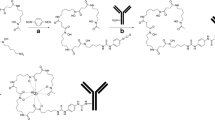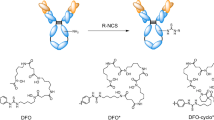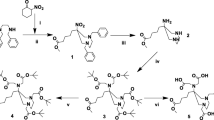ABSTRACT
Purpose
To assess the application of succinimidyl iodobenzoate (SIB) iodination method in labeling biotherapeutics to study their pharmacokinetics (PK) and biodistribution.
Method
An IgG molecule (protein-01) and a 40 KDa protein (protein-02) were evaluated. Pharmacokinetics (PK) and biodistribution of the radiolabeled IgG (125I-protein-01) in mice compared parameters from SIB and Iodogen protein iodination labeling methods. In addition, PK of radiolabeled 40 KDa protein (125I-protein-02) using SIB was compared with non-labeled protein-02 analyzed by ligand binding assay (LBA).
Results
Up to 72 h following a single IP injection to mice, the percentage of “free-label” determined by the soluble counts after TCA precipitation to total radioactivity in serum samples was 2.8–49.4% vs. <1.0% for 125I-protein-01 iodinated via Iodogen or SIB methods, respectively, suggesting a higher in vivo stability of 125I-protein-01 labeled via the SIB method. The serum exposure of 125I-protein-01 was two-fold higher, and correspondingly, the tissue exposure was also higher (averaging 3.6 fold at 168 h) when using SIB protein labeling method than when using the Iodogen method. In addition, following subcutaneous (SC) administration to mice, the serum exposure of 125I-protein-02 labeled via SIB method was similar to protein-02 measure by LBA.
Conclusion
In this study, iodination of proteins using SIB methodology has overcome the dehalogenation problem in vivo which is inherent in Iodogen method, and PK parameters of a protein iodinated via SIB were comparable to the un-labeled protein measured by LBA. The SIB iodination method is an improved labeling approach for biotherapeutics used in studying PK and biodistribution characteristics.





Similar content being viewed by others
Abbreviations
- Ab:
-
Antibody
- ADME:
-
Absorption, distribution, metabolism, excretion
- AUC:
-
Area under concentration versus time curve
- IP:
-
Intraperitoneal
- LBA:
-
Ligand-binding assays
- LC-MS:
-
Liquid chromatography-mass spectrometry
- mAb:
-
Monoclonal antibody
- MW:
-
Molecular weight
- NCS:
-
N-chlorosuccinimide
- PBS:
-
Phosphate buffered saline
- PK:
-
Pharmacokinetics
- RCP:
-
Radiochemical purity
- SDS-PAGE:
-
Sodium dodecyl sulfate polyacrylamide gel electrophoresis
- SEC:
-
Size exclusion chromatogram
- SIB:
-
Succinimidyl iodobenzoate
- TCA:
-
Trichloroacetic acid
REFERENCES
DeSilva B, Smith W, Weiner R, Kelley M, Smolec J, Lee B, et al. Recommendations for the bioanalytical method validation of ligand-binding assays to support pharmacokinetic assessments of macromolecules. Pharm Res. 2003;20:1885–900.
Lee JW, Kelley M, King LE, Yang J, Salimi-Moosavi H, Tang MT, et al. Bioanalytical approaches to quantify “total” and “free” therapeutic antibodies and their targets: technical challenges and PK/PD applications over the course of drug development. AAPS J. 2011;13:99–110.
Rup B, O’Hara D. Critical ligand binding reagent preparation/selection: when specificity depends on reagents. AAPS J. 2007;9:E148–55.
Gorovits B. Antidrug antibody assay validation: industry survey results. AAPS J. 2009;11:133–8.
O’Hara DM, Theobald V, Egan AC, Usansky J, Krishna M, TerWee J, et al. Ligand binding assays in the 21st century laboratory: recommendations for characterization and supply of critical reagents. AAPS J. 2012;14:316–28.
Domon B, Aebersold R. Mass spectrometry and protein analysis. Science. 2006;312:212–7.
Ewles M, Goodwin L. Bioanalytical approaches to analyzing peptides and proteins by LC–MS/MS. Bioanalysis. 2011;3:1379–97.
Efimova YMWB, Haemers S, Van Well AA. Changes in the secondary structure of proteins with 125I: CD spectroscopy and enzymatic activity studies. J Radioanal Nucl Chem. 2005;264:91–6.
Vugmeyster Y, DeFranco D, Szklut P, Wang Q, Xu X. Biodistribution of [125I]-labeled therapeutic proteins: application in protein drug development beyond oncology. J Pharm Sci. 2010;99:1028–45.
Khalil MM, Tremoleda JL, Bayomy TB, Gsell W. Molecular SPECT imaging: an overview. Int J Mol Imaging. 2011;2011:796025.
Chen J, Cheng Z, Miao Y, Jurisson SS, Quinn TP. Alpha-melanocyte-stimulating hormone peptide analogs labeled with technetium-99m and indium-111 for malignant melanoma targeting. Cancer. 2002;94:1196–201.
Chen J, Strand SE, Sjogren HO. Optimization of radioiodination and biotinylation of monoclonal antibody chimeric BR96: an indirect labeling using N-succinimidyl-3-(tri-n-butylstannyl)benzoate conjugate. Cancer Biother Radiopharm. 1996;11:217–26.
Khalaj ABD, Rafiee H, Najafi R. A new and simple synthesis of N-succinimidyl-4-[127/125I] iodobenzoate involving a microwave-accelerated iodination step. J Label Compd Radiopharm. 2001;44:235–40.
Wang M, Defranco D, Wright K, Quazi S, Chen J, Spencer-Pierce J, et al. Decreased subcutaneous bioavailability of an oxyntomodulin analog in a controlled release formulation could be skin metabolism in rats. J Bioequiv Availab. 2012;4:69–77.
Osterman L. Methods of protein and nucleic acid research. New York: Springer; 1984.
Wilbur DS, Hadley SW, Hylarides MD, Abrams PG, Beaumier PA, Morgan AC, et al. Development of a stable radioiodinating reagent to label monoclonal antibodies for radiotherapy of cancer. J Nucl Med. 1989;30:216–26.
Lee J, Coleman RE, Sherman LA. Comparison of iodine monochloride and modified chloramine-T radioiodination for in vivo protein studies. J Lab Clin Med. 1977;89:836–44.
Visser GW, Klok RP, Gebbinck JW, ter Linden T, van Dongen GA, Molthoff CF. Optimal quality (131)I-monoclonal antibodies on high-dose labeling in a large reaction volume and temporarily coating the antibody with IODO-GEN. J Nucl Med. 2001;42:509–19.
Bolton AE, Hunter WM. The labelling of proteins to high specific radioactivities by conjugation to a 125I-containing acylating agent. Biochem J. 1973;133:529–39.
Koehrle J, Auf’mkolk M, Rokos H, Hesch RD, Cody V. Rat liver iodothyronine monodeiodinase. Evaluation of the iodothyronine ligand-binding site. J Biol Chem. 1986;261:11613–22.
Bai H, Jing D, Jiang H, Yin S. Pharmacokinetics, tissue distribution and excretion of recombinant human parathyroid hormone 1–84 in animals. Cell Biochem Biophys. 2013;66:379–87.
Chen JQSS, Brechbiel MW, Gansow OA. Combination of biotinylation and In-111 labelling with chelate SCN-Bz-CHX-A-DTPA for chimeric BR96, biodistribution and pharmacokinetic studies in colon carcinoma isografted rats. Tumor Target. 1996;2:66–75.
Sharkey RM, Behr TM, Mattes MJ, Stein R, Griffiths GL, Shih LB, et al. Advantage of residualizing radiolabels for an internalizing antibody against the B-cell lymphoma antigen, CD22. Cancer Immunol Immunother. 1997;44:179–88.
Zalutsky MR, Narula AS. A method for the radiohalogenation of proteins resulting in decreased thyroid uptake of radioiodine. Int J Radiat Appl Instrum A. 1987;38:1051–5.
Zalutsky MR, Narula AS. Radiohalogenation of a monoclonal antibody using an N-succinimidyl 3-(tri-n-butylstannyl)benzoate intermediate. Cancer Res. 1988;48:1446–50.
Cheng Z, Chen J, Miao Y, Owen NK, Quinn TP, Jurisson SS. Modification of the structure of a metallopeptide: synthesis and biological evaluation of (111)In-labeled DOTA-conjugated rhenium-cyclized alpha-MSH analogues. J Med Chem. 2002;45:3048–56.
Ferraiolo BL, Moore JA, Crase D, Gribling P, Wilking H, Baughman RA. Pharmacokinetics and tissue distribution of recombinant human tumor necrosis factor-alpha in mice. Drug Metab Dispos. 1988;16:270–5.
Rajalingam D, Loftis C, Xu JJ, Kumar TK. Trichloroacetic acid-induced protein precipitation involves the reversible association of a stable partially structured intermediate. Protein Sci. 2009;18:980–93.
Remy H, Borget I, Leboulleux S, Guilabert N, Lavielle F, Garsi J, et al. 131I effective half-life and dosimetry in thyroid cancer patients. J Nucl Med. 2008;49:1445–50.
Motie M, Schaul KW, Potempa LA. Biodistribution and clearance of 125I-labeled C-reactive protein and 125I-labeled modified C-reactive protein in CD-1 mice. Drug Metab Dispos. 1998;26:977–81.
ACKNOWLEDGEMENTS AND DISCLOSURES
The authors would like to thank members of the Department of Comparative Medicine, Pfizer Inc, Andover, for conducting in-life animal studies; and to thank Yan Weng and Martin Dowty for providing the proteins.
Author information
Authors and Affiliations
Corresponding author
Rights and permissions
About this article
Cite this article
Chen, J., Wang, M., Joyce, A. et al. Comparison of Succinimidyl [125I]Iodobenzoate with Iodogen Iodination Methods to Study Pharmacokinetics and ADME of Biotherapeutics. Pharm Res 31, 2810–2821 (2014). https://doi.org/10.1007/s11095-014-1378-3
Received:
Accepted:
Published:
Issue Date:
DOI: https://doi.org/10.1007/s11095-014-1378-3




